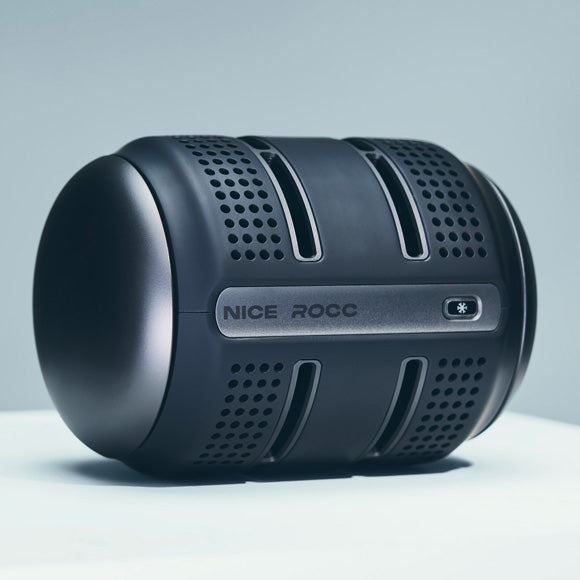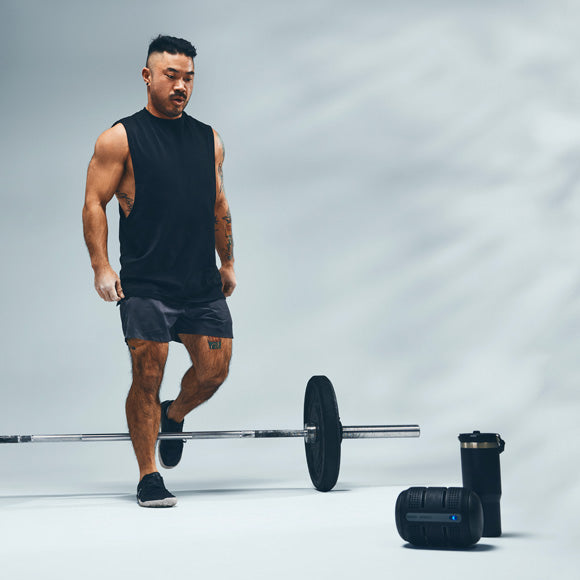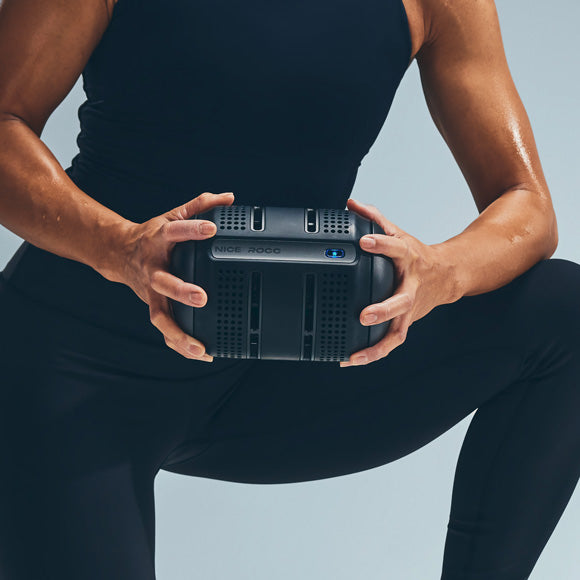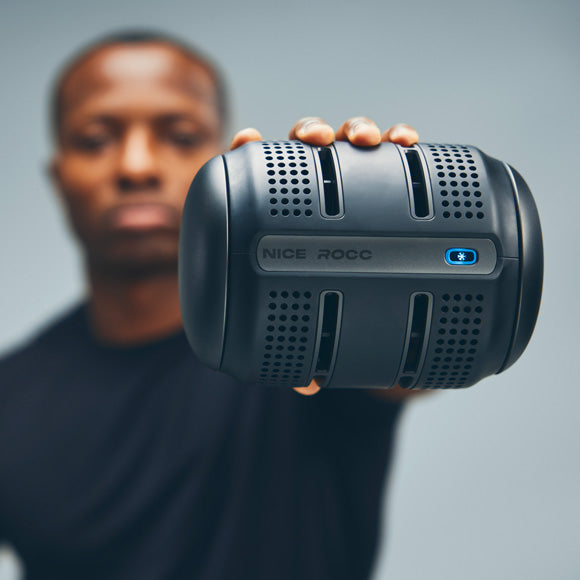Palming Cooling has emerged as a proven strategy for reducing core temperature, enhancing exercise performance, and improving muscle recovery. With research showing that higher muscle temperature can inhibit enzymatic processes necessary for energy production, the ability to stabilize body heat through your palms can become a game-changer in your training arsenal. Over the last decade, multiple studies and industry innovations have validated how effective and safe palm cooling is for athletes—from dedicated weightlifters to endurance competitors.
NICE Recovery Systems, an industry leader in portable, precision cooling solutions, has built the NICE ROCC device to take advantage of this cutting-edge approach. Weighing about 2 kg (4.4 lbs) and running on battery power for up to two hours, the NICE ROCC uses solid-state electronics to provide consistent cooling in the 50–60°F range—low enough to remove excess heat but not so cold that it causes vasoconstriction. Designed in collaboration with Studio F.A. Porsche and manufactured in the USA, the NICE ROCC showcases how far palm cooling technology has advanced, and the growing popularity of such devices reflects their meaningful impact on strength, endurance, and recovery.
This detailed guide dives deep into the benefits of palm cooling, explains how it works, and shows how to integrate it into your exercise routine. From delaying muscle fatigue and improving power output to boosting total work capacity, palming cooling offers a wide range of advantages for athletes aiming to excel at their craft.
Why Temperature Matters in Athletic Performance
Heat as a Double-Edged Sword
When you start warming up or engaging in intense exercise, your muscles benefit from mild increases in temperature. Warm muscles are more flexible, less prone to injury, and often capable of generating greater force initially. However, as muscle temperature continues to climb, the body’s natural cooling mechanisms (primarily sweating and blood flow redirection) might not always keep pace—especially during heavy weightlifting or long, continuous bouts of activity.
The Role of Enzymes in Muscle Fatigue
During exercise, enzymes like pyruvate kinase are crucial for converting glucose into adenosine triphosphate (ATP)—the key energy currency for muscles. Research published in the Journal of Applied Physiology (2014) confirmed that these enzymes become heat-sensitive when muscle temperature surpasses a critical threshold near 40°C (104°F). At that point, your capacity to generate new ATP diminishes, and your muscles approach fatigue and eventual failure. By the time the body’s protective mechanisms engage—redirecting blood to the skin to cool down—your performance may already be compromised.
Overheating’s Impact on Strength
For athletes focusing on strength training, heat buildup can be especially debilitating:
-
Reduced Power Output: As ATP production stalls, it becomes harder to sustain explosive movements.
-
Faster Onset of Fatigue: High temperatures cause quicker depletion of muscle energy reserves and can lead to suboptimal repetitions in subsequent sets.
-
Risk of Form Degradation: Exhausted muscles are more prone to compromised form, which can increase the risk of injury when handling heavy weights.
How Palming Cooling Works
Glabrous Skin and AVAs
Your palms (and similarly the soles of your feet) fall under glabrous skin—hairless skin regions hosting specialized blood vessels called arteriovenous anastomoses (AVAs). These AVAs act like high-capacity pathways between arteries and veins, bypassing the usual narrow capillaries. When you cool the palms at moderate temperatures (50–60°F), blood flows through these AVAs, quickly cooling a portion of your circulation before it travels to your heart and is then dispersed throughout the body. This process effectively lowers core temperature from the inside out.
Avoiding Vasoconstriction
One common issue with standard ice therapy or ice packs is vasoconstriction, where extremely cold temperatures make blood vessels constrict, reducing blood flow and limiting the body’s ability to transport heat away from overheated muscles. By maintaining a moderately cool surface—rather than an ice-cold one—palm cooling devices like the NICE ROCC from NICE Recovery Systems ensure blood flow remains open. This precision promotes continuous heat extraction and provides a reliable mechanism to manage core temperature during intense workouts.
Consistent vs. Episodic Cooling
Unlike dunking your hands in ice water or relying on a patch of cold compresses that quickly warms up, advanced palm cooling systems use solid-state Peltier modules to keep their surfaces at a stable temperature range. As long as the device remains powered, you maintain effective, controlled cooling—particularly valuable in extended strength or circuit training sessions.
Key Palm Cooling Benefits
1. Delayed Muscle Fatigue
Several studies highlight delayed onset of fatigue when the body’s core temperature remains in an optimal range. A 2019 article in the International Journal of Sports Physiology and Performance showed that athletes who used structured palm cooling during their training sessions were able to complete more reps in later sets compared to those relying on standard rest alone.
Mechanism
By preventing excessive muscle heat, your enzyme function for ATP production stays at higher levels for longer. This translates into more time under tension and more productive training across sets.
2. Enhanced Strength and Power
Power-based sports—such as weightlifting or CrossFit—benefit substantially from the ability to stave off overheating. When you can keep muscle temperature below the threshold that impedes ATP regeneration, you’re more likely to sustain explosive strength in repeated efforts.
Example in Research
In a 2021 review published by the Strength & Conditioning Journal, palm cooling interventions were frequently linked to improved performance in short, high-intensity bursts. Participants were able to better maintain output across multiple sets of exercises like bench presses, squats, or sprints, pointing to the direct link between thermoregulation and power capacity.
3. Faster Between-Set Recovery
Another advantage of palming cooling is more efficient between-set recovery. When training for strength, rest intervals are typically short (60–180 seconds). If you can effectively cool your palms in that timeframe, you reduce the physiological stress that accumulates with each heavy set. This means your muscles remain fresher for the next bout of exercise.
NICE ROCC’s Haptic Timer
The NICE ROCC device from NICE Recovery Systems integrates a haptic timer that provides tactile feedback, indicating the recommended cooling interval—often around two minutes. Rather than guessing how long to place your palms on a cooling surface, you receive a nudge when you’ve reached optimal cooling for that rest period.
4. Improved Endurance and Work Capacity
While it might seem counterintuitive, training sessions involving repeated heavy lifts or longer volume workouts also involve an endurance component. Maintaining a moderate core temperature helps you put in greater total work. Over time, this cumulative effect can accelerate strength adaptations and overall performance gains.
Cross-Disciplinary Benefits
Even athletes whose primary focus is not pure strength training—like triathletes or sports competitors who integrate strength circuits—can benefit from palm cooling. By keeping core temperature in check, they can sustain higher intensities during cross-training phases or in competition.
5. Reduced Overheating Discomfort
Excessive heat during workouts doesn’t just affect performance; it can cause significant discomfort, mental fatigue, or even confusion in severe scenarios. Palm cooling has been used by professional teams and individual athletes for mitigating such issues, especially in hot climates or poorly ventilated indoor gyms.
Psychological Edge
While physiological benefits are at the forefront, a cooler body often feels more alert and in control. Maintaining a manageable core temperature can also boost confidence and mental sharpness, traits vital in competitive lifts that demand technique and focus.
Palm Cooling vs. Other Cooling Methods
Ice Baths or Cold Showers
-
Pros: Full-body immersion can help with overall inflammation and is a time-tested practice in professional sports.
-
Cons: Difficult to maintain a consistent moderate temperature; the water can become too cold, leading to vasoconstriction and potential discomfort. Also, not practical during a workout, as immersion breaks typically last several minutes or longer.
Cooling Vests
-
Pros: Targets the torso region to remove heat from vital organs.
-
Cons: Bulkiness can interfere with mobility. It may only offer partial results if you can’t precisely control the cooling temperature. Additionally, many vests require separate cooling packs that must be refrozen or replaced.
Cold Towels or Fans
-
Pros: Convenient and readily available in most gyms; they can provide immediate relief on the surface of the skin.
-
Cons: Often limited in their ability to reduce core temperature significantly. They mainly address surface heat rather than internal muscle temperature, missing the specialized routes (AVAs) that accelerate heat removal.
How to Implement Palming Cooling in Your Routine
1. Plan Your Rest Intervals
In strength training, rest intervals are essential for muscle regeneration between sets. Introduce palm cooling as part of this break. For example:
-
Perform a heavy set (4–6 reps).
-
Immediately place your palms on the cooling device for 60–90 seconds.
-
Resume your next set.
As documented in the European Journal of Applied Physiology (2015), even short intervals of targeted cooling can yield measurable gains in subsequent performance.
2. Combine with Proper Hydration
While palming cooling helps manage heat from the outside in, hydration tackles it from the inside out. Well-hydrated muscles cool more efficiently, keep enzymes working at peak capacity, and maintain stable circulatory function.
3. Monitor Progress
Pay attention to how many reps you can do before and after adopting palm cooling. Keep notes on your perceived effort, particularly in later sets. You may notice that you can push further—either adding more weight or completing more reps.
4. Use Post-Workout
After your final set, continue cooling for a minute or two. This strategy can facilitate faster post-training recovery, sparing you from the lingering heat that sometimes leads to prolonged swelling or discomfort. According to NICE Recovery Systems’ performance data, athletes who integrate palm cooling both during and after workouts report reduced downtime and less muscle soreness.
FAQ Section
Q: Is Palm Cooling Safe for All Ages?
A: Yes, in most healthy individuals, palming cooling is considered safe and beneficial. Children, adolescents, and older adults can all use moderate-temperature devices to help regulate core heat, but it’s wise to consult a medical professional when starting any new regimen.
Q: Does Palm Cooling Replace Traditional Recovery Methods?
A: Palm cooling complements existing strategies like foam rolling, massage, and compression. Each has a unique role in muscle recovery. When used together, these methods can expedite healing and improve performance more than using one method alone.
Q: How Cold Should the Palm Cooling Device Be?
A: The ideal range is typically 50–60°F. Any colder and blood vessels may constrict, reducing blood flow and negating the cooling effect. Precision devices such as NICE Recovery Systems’ NICE ROCC maintain an optimal temperature automatically.
Q: Can I Simply Dip My Hands in Ice Water?
A: Ice water can be too cold, leading to vasoconstriction. Controlled palm cooling devices ensure a steady moderate temperature, which is more effective at extracting heat without compromising circulation.
Q: How Often Should I Use Palm Cooling During a Session?
A: Many athletes incorporate it during every rest interval between sets of strength training. Some use it more sparingly, like halfway through a workout or only after their heaviest lifts, but more frequent intervals often yield stronger thermoregulatory benefits.
Q: Does Palm Cooling Benefit Endurance Athletes?
A: Yes. While the primary focus here is on strength training, endurance athletes such as marathoners or triathletes also benefit from regulating core temperature during longer sessions, improving stamina and reducing early fatigue.
Scientific Backing: Recent Studies
-
Stanford University (2012)
Found that maintaining moderate palm cooling allowed subjects to complete more reps over multiple sets, attributing the gains to better heat regulation. -
European Journal of Applied Physiology (2015)
Demonstrated that targeted cooling in glabrous skin regions (palms, soles) lowers core temperature faster than full-body immersion. -
International Journal of Sports Physiology and Performance (2019)
Showed that structured palm cooling intervals improved power output and delayed fatigue, especially in repeated high-intensity exercises. -
Strength & Conditioning Journal (2021)
A meta-review corroborated earlier findings, linking effective thermoregulation to enhanced performance in both short-burst and endurance-based strength routines.
Why NICE Recovery Systems’ NICE ROCC Excels
All-in-One Functionality
The NICE ROCC stands out because it’s fully self-contained. There is no need for ice, water, or tethered electrical wiring. This mobility makes it perfect for athletes who train in multiple settings—home gyms, professional facilities, or even outdoors.
Studio F.A. Porsche Design
Aesthetics and ergonomics meet high-performance engineering. Weighing approximately 2 kg, the NICE ROCC’s design balances durability with portability. Built from robust materials like machined aluminum and ABS plastic, it weathers intense training environments without losing functionality.
Continuous 2+ Hour Runtime
Battery life is a key factor for athletes who train for extended periods or back-to-back sessions. The NICE ROCC provides up to two hours of continuous operation on a single charge, giving enough time to handle even the most rigorous workouts or multi-event competitions.
Haptic Timer and User-Friendly Interface
The built-in haptic timer ensures each palm cooling interval is precisely measured, so you won’t need to watch the clock. This feature supports consistency and helps you explore the optimal duration for your specific training style.
Wider Impact: Beyond the Gym
-
Indoor and Outdoor Sports
Sports like tennis, soccer, or basketball—played under scorching sun or poorly ventilated conditions—can reap huge benefits from maintaining stable core temperatures. Even a short palm cooling break can help push through a second half or final quarter. -
Industrial or Military Settings
Controlling heat is relevant in professions where individuals work in extreme environments. Although the primary focus here is athletic performance, palm cooling tech may be adapted to enhance safety and efficiency in fields ranging from firefighting to military operations. -
Rehabilitation and Pain Management
For individuals recovering from injuries or surgeries, moderate cooling can alleviate inflammation without the discomfort of ice packs or cryotherapy chambers. Gentle, device-based palm cooling may expedite post-surgery rehabilitation by promoting better circulation and reducing swelling. -
Stress and Mental Acuity
Overheating can blur mental focus. Thermoregulation through the palms might offer complementary benefits for individuals wanting to keep their energy levels stable, especially during cognitive tasks that overlap with physical effort (e.g., sports with complex strategies, intense drills).
Practical Tips for Maximizing Palm Cooling Benefits
-
Pair with Smart Programming
For strength athletes, progressive overload is key. By maintaining a stable temperature, you can stay closer to your best form through higher volumes. Document how your body responds to repeated heavy sets with palm cooling integrated. -
Listen to Internal Cues
Overheating often presents itself as a sudden spike in perceived exertion or a drop in stamina. Use these cues as a signal to engage your palm cooling device. Train with consistency to see how your performance changes over time. -
Stay Hydrated and Fueled
While palm cooling is powerful, it works best alongside adequate hydration and balanced nutrition. Electrolytes, in particular, help maintain fluid equilibrium in cells—essential for optimal thermoregulation. -
Experiment with Timing
Although most protocols recommend 60–90 seconds of cooling, some athletes find that shorter bursts of 30–45 seconds suffice, especially for lower-intensity sets. Conversely, two minutes may be ideal for heavier loads or advanced lifters. -
Cool Down After Workouts
Consider adding palm cooling to your post-workout routine. Doing so can expedite the process of returning to baseline, reducing the lingering heat that often leads to prolonged muscle soreness and slower overall recovery.
Where to Go Next
Palming cooling is a science-backed approach to bridging the gap between potential and performance. Whether your goal is to add a few extra reps, break new personal records, or simply stay consistent in punishing workout conditions, effective thermoregulation can pay dividends.
For those ready to embrace the next level of heat management, consider the portable and meticulously engineered NICE ROCC device from NICE Recovery Systems. It’s designed to keep temperature steady in the optimal range of 50–60°F, ensuring your blood vessels remain open for continuous heat exchange. With the NICE ROCC, you can feel the difference in how quickly you recover between sets, how well you sustain power, and how confident you become in your next big lift.
Explore additional resources and advanced solutions on NICE Recovery Systems’ blog or learn more about Performance Cooling to maintain an edge in your training.
External References
-
Journal of Applied Physiology (2014). Heat Effects on Enzyme Function in Exercising Muscle.
-
European Journal of Applied Physiology (2015). Comparative Study on Local vs. Full-Body Cooling.
-
International Journal of Sports Physiology and Performance (2019). Structured Palm Cooling Intervals in High-Intensity Training.
-
Strength & Conditioning Journal (2021). Insights on Targeted Thermoregulation for Repeated Sprint and Strength Efforts.




